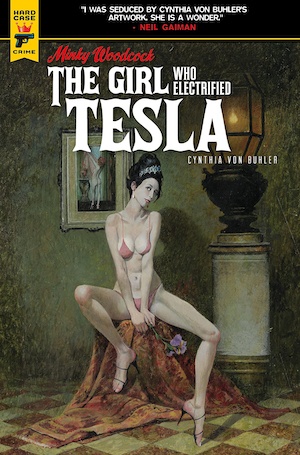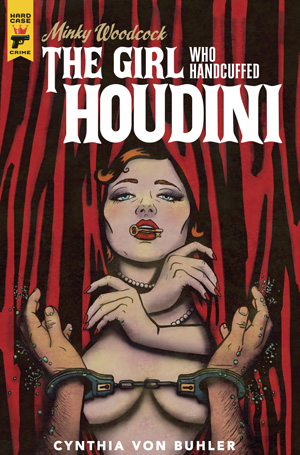Cynthia von Buhler has an inspiring range of talents. In addition to writing and performing in immersive theatre productions, she’s a fine artist and a writer, and she illustrates her own crime stories. Her favourite milieu is the early 20th century – a period during which many of her family’s best stories took place. For example, her grandparents ran speakeasies in The Bronx in the 1920s, and one of her grandfathers was murdered in the street in 1935. The crime remains a mystery.
And a mystery is something Cynthia has always adored. One of her creations is Minky Woodcock, the woman detective we first met in Minky Woodcock: The Girl Who Handcuffed Houdini. There, she started off working in her father’s private detective agency. In Cynthia von Buhler’s latest graphic novel, Minky is 20 years older and her case involves the great inventor, Nikola Tesla. Once again, Cynthia has written the story and created all the artwork. We asked her to join us for an interview:
How is everything and what have you been up to since The Girl Who Handcuffed Houdini?
It’s been a crazy two years with the pandemic, hasn’t it? I’m doing well and have been keeping busy working on books. I researched, wrote, and drew the latest Minky Woodcock episode, The Girl Who Electrified Tesla, and have been working on a graphic novel for a younger audience as well.

What are crime fiction lovers going to love about The Girl Who Electrified Tesla?
Once again, the facts of my investigation are based on actual evidence, and much of it is bizarre and doesn’t seem like it could be true, yet it is. The only part that is fiction is my character Minky Woodcock and how her life is tied into the story. In this episode Minky partners with Josephine Baker romantically and professionally. Many people don’t realise that Baker was a spy for the French during WWII. We also meet a Nazi spy, Otto Skorzency, the JP Morgan family, and Donald Trump’s uncle, who was an electrical engineer working for the government at the time of Nikola Tesla’s mysterious death.
Tell us a bit more about Minky – how did you conceive her and how has she developed since Houdini?
My bootlegging, speakeasy-owning grandfather was murdered in 1935. Years ago, I started investigating his unsolved death and found connections to the mob, such as the infamous Dutch Schultz. Since then I’ve been investigating other mysterious murderers from the 20s, 30s, and 40s. In the past ten years I’ve staged four immersive theatre productions based on these stories in New York City. In this episode we fast forward to 1943. Minky has been taking on cases all these years and her father still hasn’t fully accepted her into the business. She’s older and wiser, however she still gets far too wrapped up in her cases.
What are some of the things that fascinated you about Tesla, and how have you brought him to life here?
He was a man before his time. He believed in harvesting free, clean energy to provide to the world. If he had been nurtured, and not thwarted by greedy competitors, we might not be in the current climate crisis. Tesla strongly believed in feminine intelligence and he adored animals, particularly pigeons. I try to show his quirky genius. He had a childlike wonder about the world, perhaps a bit naïve, and a kind heart. Tesla wasn’t interested in profit, he cared about making the world a better place.
Tell us a little more about some of the other historical figures in the story, and how you brought them together?
Most people interested in Nikola Tesla know about his competitive relationship with Thomas Edison. My book moves beyond that. Most people don’t realise that JP Morgan bought Edison’s company which became General Electric. The Morgan family was purely interested in profit. They realised that Tesla was a genius and tried to keep him under their thumb. Tesla wanted to make free power available to all. Three generations of Morgans thwarted him because they wanted people to pay for energy.
This story takes place during WWII and we meet the infamous Nazi operative and spy, Otto Skorzency, also known as Scarface. Germany was trying to get a hold of Tesla’s plans for a death ray.
We also meet John Trump, Donald Trump’s uncle. He was an electrical engineer, inventor and physicist. After Tesla died, the government asked Trump to confiscate the death ray plans to see if they were viable. The interesting thing is that the most important page of the document was missing – and still is. My story revolves around this fact.
And of course, Josephine Baker has a starring role in this episode.

What is it that attracts you to the aesthetic, the history and the creativity of the early 20th century? It’s a big part of the visual language you’ve developed across your work.
I love that time because it’s when female roles in society started to change. Women fought for the right to vote, took jobs usually reserved for men, and became freer sexually. We are still in this fight for equality and that was when it started to make inroads.
Are there any parallels with today that you’re exploring here? Or key differences in how things were then and how they are today?
We are still struggling with profit and power over doing the right thing. I think the human race is at a crossroads now. If we do the right thing we might survive, if not we might go the way of the dinosaurs.
Minky wasn’t afraid to use here sexuality in the Houdini story. Is she similarly adventurous and liberated here, and for you why is this an important dimension in your stories?
Minky is living her life. She’s attracted to Otto Skorzency. I doubt she would have had sex with him had she known who he really was. She was disgusted with herself afterwards. She genuinely likes Baker and they connect on many levels. Minky finds Tesla refreshing in that he’s interested in her as a person and not only as a sexual object.
You’re a wonderful illustrator and writer too. Was it the drawing that took you towards the words, or the words that took you towards illustration, here with these graphic novels?
Thank you. The words and the research always come first.
What crime fiction do you read?
I read about actual historic crimes and I enjoy trying to figure out what occurred and why. Many years ago I bought a set of books called Crimes and Punishment: A Pictorial Encyclopedia of Aberrant Behavior at a flea market. It’s a picture book of horrific true crimes from history. I find it fascinating to try and understand why crimes are committed and how they are investigated.
Will there be a live performance version of Tesla, as per Houdini, and if so what will that be like?
Due to Covid I’m not planning any theatre productions at this time. I am planning to hold a few book release parties with a Tesla theme and performers in the next few months though, perhaps in Manhattan, London and Boston.
What’s next for CVB?
I’m working on more graphic novels. I have one in the works for a younger audience. I’m also interested in bringing my books to television or film as well as theatre. And if people are interested, Minky has many more investigations up her sleeves.
Minky Woodcock: The Girl Who Electrified Tesla is out as a graphic novel on 30 November. For more on her see www.MinkyWoodcock.com. Main photo by Maxine Nienow.
